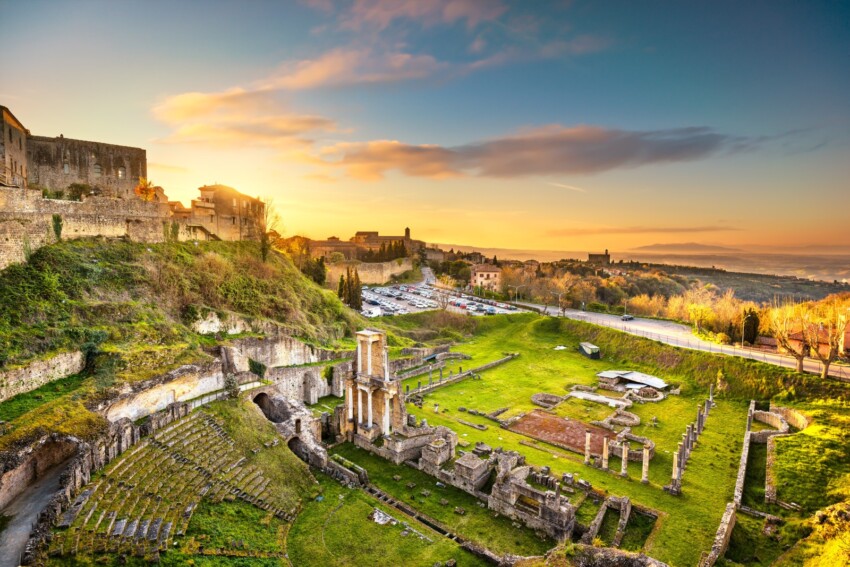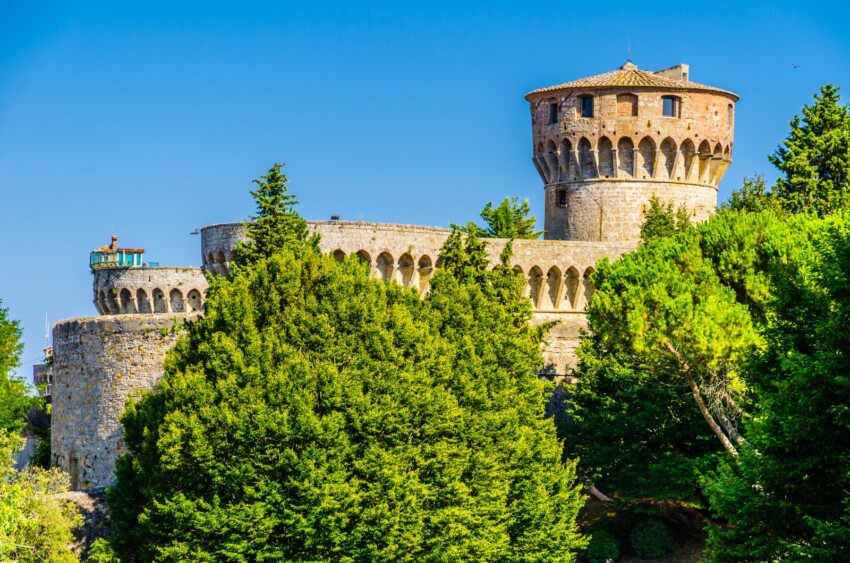

In the heart of the Pisan countryside, but also close to the borders of the provinces of Siena and Livorno, lies the beautiful Volterra. This town of 10,000 inhabitants was one of the main city-states of ancient Etruria, very powerful in the Middle Ages and with a historical centre of Etruscan origin.
Today, Volterra is a very popular tourist destination, a must for those who choose to visit Tuscany, thanks above all to the beauty of its historic centre, but also for its centuries-old tradition in the extraction and working of alabaster, with which the skilful hands of the city’s craftsmen churn out truly beautiful objects.
Finally, Volterra has achieved international fame in recent years as one of the settings for the successful Twilight saga: author Stephenie Meyer made Volterra the city of residence of the Volturi, a powerful vampire clan. Some of the scenes of the TV series I Medici, during the second and third seasons, were also filmed in Volterra.
Whether you want to follow in the footsteps of your favourite film stars or explore the town in complete freedom, here are the best things to see in Volterra, so that you don’t miss a single one and return home more than satisfied.

The beautiful Palazzo dei Priori is one of Volterra‘s main attractions. It is located in Piazza dei Priori, and has the distinction of being the oldest municipal palace in Tuscany. Its architectural style is very reminiscent of Palazzo Vecchio in Florence, but it has a history and personality all of its own. Built in the early 1200s, today it houses the offices of the municipality of Volterra, but in the past it served as the seat of the 18 Priori del Popolo.
On the outside, the stone façade is characterised by string-course cornices and semicircular merlons, and is decorated with terracotta plaques recalling ancient Florentine families, evidence of the fact that Volterra was governed by the city of Florence from the 15th century. The façade is surmounted by a tall tower, dating back to the 16th century, and rebuilt 150 years later, following damage caused by the earthquake of 1846.
Inside, visit the elegant atrium, where the coats of arms of the city’s priors are displayed. Don’t miss the magnificent Council Chamber, the most representative of the palace, located on the first floor. The upper floors, now used as offices of the Municipality of Volterra, originally housed the Priors’ bedrooms, as well as a hall for meetings and meals.

The cathedral of Volterra, officially the Cathedral of Santa Maria Assunta, is the city’s main church. It is built in Romanesque and Baroque style, and its construction lasted for six centuries, from the 12th to the 18th century.
Visit its interior, with its Latin cross plan and three naves divided by no less than 22 pink stucco columns and white capitals. Much of what you can admire inside the Volterra cathedral dates back to a major restoration in the mid 19th century, including the grey and white striped walls, the presbytery and the floor. When you find yourself in the nave, look up and admire the splendid coffered ceiling with geometric and decorative motifs, while to the sides of the aisles are six chapels, housing works of art by numerous painters from the late 16th century.
The oldest work of art preserved inside the cathedral of Volterra is the sculptural group of the Deposition, dating back to the 13th century and made by local craftsmen. It depicts Jesus Christ being deposed from the cross by the Madonna, St. John the Evangelist, Joseph of Arimathea and Nicodemus.

In the 1950s, an ancient Roman theatre was brought to light in Volterra, thanks to a series of archaeological excavations north of the historic centre. The theatre has been dated to the end of the 1st century BC, and is excavated in the natural slope of a small relief, just like Greek theatres. In addition to the theatre, excavations have unearthed seats and some of the staircases.
It is estimated that the theatre could hold up to 3500 spectators, and it also contained a velarium, i.e. a curtain supported by ropes, a covering that made it usable even in adverse weather conditions. The theatre can be visited as it is contained within an archaeological area, which can be accessed just outside Porta Fiorentina.
Today, Volterra’s Roman theatre has also returned to its former glory as a venue for events and performances, as the International Festival takes place here every year, where a qualified jury awards the Ombra della Sera prizes to important personalities from the world of entertainment and culture.

The Florentine domination of Volterra is also noted in the city by the presence of the Fortezza Medicea, an imposing building composed of two separate bodies joined by high defensive walls. They are the Rocca Vecchia, or Cassero, and the Rocca Nuova, or Mastio.
The first part that was built was the Rocca Vecchia, erected by the Duke of Athens, Volterra’s ‘neutral’ leader during the 14th century, to try to prevent the city’s most important families from waging war to dominate the city. It is flanked by the Rocca Nuova, built directly by Lorenzo dè Medici by destroying two quarters and the bishop’s palace.
The Medici Fortress of Volterra is today a state prison and therefore cannot be visited, unless special exceptions are made.
Opposite the cathedral stands the Baptistery of St. John, an octagonal building dating back to the second half of the 13th century. The façade facing the cathedral is very beautiful and characteristic, with white and green marble bands, where the majestic Romanesque-style portal is located.
Inside, the baptistery of St. John has six niches and an altar, the latter dating back to the 18th century. There are some very important decorations, including an Ascension by Niccolò Cercignani, painted on wood, while to the right of the altar is the ancient baptismal font, the work of Andrea Sansovino and dating back to 1502. In the centre of the baptistery is a large baptismal font, surmounted by a statue of St John the Baptist, dating back to 1759 and the work of Giovanni Vaccà.
In Via Don Minzoni in Volterra is the Guarnacci Etruscan Museum, one of the city’s main attractions. It showcases Volterra’s Etruscan past, with an extensive collection of ancient art spanning no less than 38 rooms, arranged over three floors plus the garden and all interconnected.
The Etruscan museum originated at the end of the 18th century thanks to a number of private donations, the most important of which was that of Monsignor Mario Guarnacci, who donated his entire collection to the newly established museum, so much so that the museum was initially housed inside Palazzo Ruggeri, the Guarnacci family’s private home.
Inside the museum you can visit the world’s largest collection of Etruscan urns. Highlights include the Stele of Avile Tite, the bronze statuette Ombra della sera, the terracotta urn of the bride and groom, and the Lorenzini head.
TheAbbey of Saints Justus and Clement is a religious building that is now abandoned and in a state of disrepair, due to the 1846 earthquake. But it is precisely this state that makes it truly unique, and in some ways one of the most beautiful and special things to see in Volterra.
The late Renaissance façade, apse and bell tower of the church are still standing. The numerous works of art originally present have been transferred to other buildings in the city, including the diocesan museum of sacred art, the church of San Giusto, the Volterra picture gallery and civic museum, and the municipal library.
The Abbey of Saints Justus and Clement is located north of the city of Volterra, a short distance from the famous Balze. It can be reached by driving north along the SP15 road for just over 2 kilometres.
It is impossible to leave Volterra without taking a wonderful photo of its Balze at sunset. The Balze of Volterra are rock formations located near the town, extending over an area of almost 90 hectares; they are typical rock and clay formations, reaching heights of up to hundreds of metres. When you visit them, you can admire breathtaking views, with steep walls and many shades of colour.
It is possible to see the Volterra crags from some observation points, or to approach them via some paths. There is also a well-marked belvedere , easy to reach and from which you can admire a splendid panorama.
In the following map you can see the location of the main places of interest mentioned in this article.

Fans of the successful Twilight saga will already be familiar with Volterra: in fact, it is here that some scenes from the New Moon episode are set. In the book, Volterra is referred to as the town where members of the Volturi clan, a royal family of vampires who must ensure that the laws are respected, live.
Volterra is also where Edward Cullen decides to sacrifice himself, as he is convinced that his beloved Bella has taken her own life. Next to the square, in Mazzoni Alley, according to the geography of the saga is the manhole used by the vampires to descend into the dungeon.
Not everyone knows, however, that scenes from the film Twilight New Moon were filmed in Montepulciano: it was here that Robert Pattinson and Kristen Stewart made the vampire love story come true. During filming, the town was crowded with more than a thousand extras dressed in red, in one of the highlights of the entire saga, shot in Tuscany between 26 and 29 May 2009.
Choosing the historical centre to stay in Volterra is a very good choice, as this is where all the main sights are located. As is often the case, there are mainly flats, B&Bs and small charming hotels. For the larger hotels, it is necessary to move a little away from the centre, while for those who want total peace and quiet, there are many agritourisms around Volterra, to enjoy a holiday immersed in the relaxation of the Tuscan countryside.
From Florence , Volterra can be reached in about an hour and a half by car, driving south on the Florence-Siena motorway, exiting at Colle Val d’Elsa Nord. From here, continue along the SS68 state road heading east, which leads directly to the centre of Volterra. In all, about 80 kilometres must be travelled.
Even from the provincial capital Pisa, the distance is not short: we are talking about 70 kilometres, which can be covered in about one hour and 15 minutes. To get to Volterra from Pisa, take the FI-PI-LI motorway in the direction of Florence to Pontedera, and then proceed south along the SP11 through Montechiari, Peccioli, La Sterza and then Volterra.
Reaching Volterra by public transport is neither too easy nor too fast. From Pisa one travels by train to Pontedera and then continues by bus number 500, from Florence one travels by Tiemme regional buses number 131 to Colle Val d’Elsa and then 770 to Pontedera, ditto from Siena. The journey by public transport from each of the three provincial capitals takes about two hours.
What's the weather at Volterra? Below are the temperatures and the weather forecast at Volterra for the next few days.
Volterra is located in the heart of Tuscany, in the province of Pisa but not far from the border with Siena, so that Colle Val d'Elsa and San Gimignano are only 30-40 minutes away. It is also convenient with respect to the sea: Cecina, on the Tuscan coast, is about 40 kilometres away.